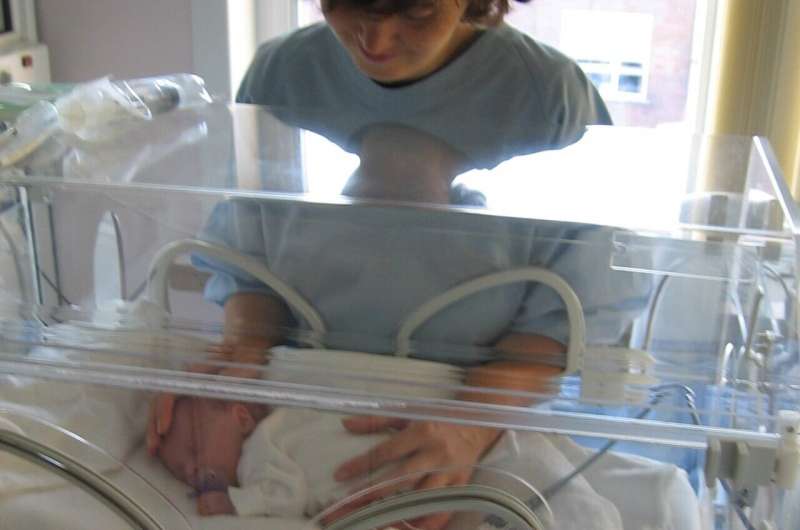This article has been reviewed according to Science X's editorial process and policies. Editors have highlighted the following attributes while ensuring the content's credibility:
fact-checked
peer-reviewed publication
trusted source
proofread
Study finds preterm-born children fit into three profiles, with different results in cognition and behavior tests

About 13 million babies each year are born prematurely, with preterm birth linked to increases in risk for attention-deficit/hyperactivity disorder (ADHD), problems with social development, and lower grades.
A problem with past analyses of prematurity, however, is that they do not capture the variety seen in children born pre-term, including some with outcomes better than the average results for full- term children. Pre-term means birth before 37 weeks of gestation, with full term being 40 weeks.
The tendency to lump preterm babies into one group hinders efforts to tailor care for any one child, researchers say. Now a new study, published online August 13 in the journal Child Development, finds that preterm-born children fit into three profiles, with markedly different results on tests that measure cognition (thinking, reasoning, remembering) and behavior (ability to pay attention).
Led by researchers at NYU Grossman School of Medicine, the analysis defined the first neurocognitive profile, made up 19.7% of all children tested, as performing above the average for even full-term children on standard cognition tests.
A second profile, representing 41% of the children, showed scores above the norm for four tests (e.g., on memory, vocabulary, and reading) and below the norm for three others (pattern recognition and working memory).
A third profile (39.3%) scored below the norm on all tests, with the cognitive deficits seen in this group found to correspond with attention deficits and lower grades in school. Specifically, children born prematurely in profile 1 did an average of 21% better on standard cognitive tests than those in profile 3. In behavioral tests, the study found that 2.5% of children in profile 1 went on to have attention deficits compared with 9.9% in profile 3.
As for academic performance, 66.47% of students in profile 1 had a grade average of A- or above, 60.69% had an A- or above average in group 2, and 32.21% had an average of A- or above in profile 3.
"Our study dispels the notion that every preterm child is born with cognitive and behavioral deficits," says lead study author Iris Menu, Ph.D., a post-doctoral scholar in the laboratory of Moriah Thomason, Ph.D., vice chair for research in the Department of Child and Adolescent Psychiatry.
"Precision psychiatry is not based on a general diagnosis, because two patients with the same diagnosis, like preterm birth, may have totally different experiences," said Thomason, senior author on the new study. "Our work highlights the complexity of preterm birth, and promises to improve treatment for each individual child."
The current study analyzed cognitive and behavioral data in 1,891 boys and girls who were born prematurely, that had aged to between 9 and 11 years, and who were enrolled in another large, ongoing study: the Adolescent Brain Cognitive Development (ABCD) study.
It tracks cognition in each child using a standard set of seven tests that measure attention, decision-making, memory, reading comprehension, and processing speed. The researchers then applied a statistical technique to each child's results to sort them into previously hidden subgroups that better represent the "real developmental landscape."
Brain differences
Neuroimaging of each child revealed that children aged 9 to 11 from profile 3 had brains that were on average 3% smaller, in volume and surface area of gray matter, than children in profile 1. While children in profile 3 were born on average 4.5 days earlier than the other profiles, smaller brain volumes were not tied to how prematurely the children were born.
The question of whether some of the differences in outcomes between children could be linked to smaller developmental brain volume warrants further investigation, along with its causes, the study authors say.
The research team also looked at functional connectivity, which measures activity levels in two connected brain circuits by measuring blood flow to them with a technique called functional MRI. For one key pair of networks—the dorsal attention network and the default mode network—connectivity between them was found to be on average 11.21% weaker in profile 3 than in profile 1.
With dorsal attention network known to play a role in sustaining attention, the functional connectivity results affirm the potential of the team's profiling approach to enable earlier diagnoses (e.g., potentially for conditions like ADHD), and more tailored behavioral therapy and drug treatment, the authors say.
Importantly, the team's analyses also found that preterm children who were Black had nearly four times as great a chance of falling into the lower-performing profile 3.
"Based on these results, we call for the launch of social and structural interventions that ensure all preterm-born children receive equitable care," said Menu.
"Children that get speech, physical, and behavioral therapy almost every day, which is more likely to happen in affluent households, tend do better on the study tests, but there are other factors involved. For instance, children in communities where more are covered by health insurance were less likely to belong to profile 3."
Moving forward, the research team plans further studies to identify factors common to kids born prematurely who performed poorly later (e.g. were such children more likely to have experienced low oxygen supply during birth), as well as factors that helped 20% of the preterm kids in profile 1 perform better than many full-term children.
Along with Menu and Thomason, NYU Langone authors were Lanxin Ji, Tanya Bhatia, Mark Duffy, and Cassandra Hendrix in the Department of Child & Adolescent Psychiatry.
More information: Beyond average outcomes: A latent profile analysis of diverse developmental trajectories in preterm and early term-born children from the Adolescent Brain Cognitive Development study, Child Development (2024). DOI: 10.1111/cdev.14143




















